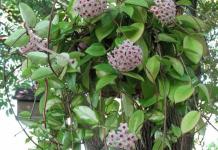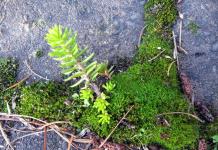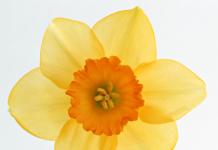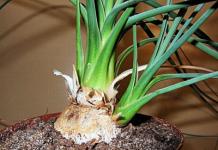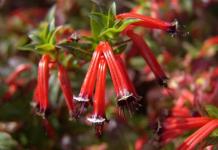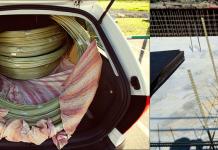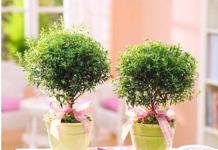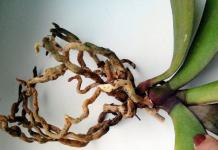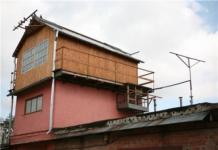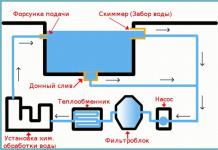The glossy sparkle of foliage and the velvety charm of star-shaped corollas, collected in dense umbrellas of inflorescences, attract lovers of indoor vines. Caring for hoya at home will appeal to both a disciplined gardener and a person who is forgetful or often travels on business. Interior designers love to use the plant for - the shiny leaves of the hoya give the green wall a special shimmering effect.
The genus Hoya of the Kutrovaceae family includes 51 plant species, but about 450 names are in a state of uncertainty. Under natural conditions, hoyas grow in India, China, the islands of the Malay Archipelago, South Korea and the northeastern edge of the Australian continent. The plant received its name in honor of the English gardener T. Hoy, who devoted his entire life to growing tropical plants in the greenhouses of the Duke of Northumberland.
Botanical portrait
Hoyas are perennial plants with climbing, climbing, and sometimes drooping stems. Their leaves are fleshy, leathery, deep emerald in color, with a characteristic sheen, up to 20 cm long, 5 cm wide, located oppositely along the pagons.
The flowers have a complex structure, are snow-white, cream, lemon yellow, pink or salmon-scarlet, collected in axillary inflorescences. The corollas are five-lobed, the petals are fleshy, smooth, and feel like velvet.
The most popular types in indoor culture are:

Hoya propagation at home
Flower growers practice sowing seeds and rooting stem cuttings. With a certain amount of patience, it is possible to grow hoya from a separate leaf blade. Before propagating hoya at home, you need to familiarize yourself with the existing methods of obtaining new plants.
The best time to propagate hoya is the beginning of the growing season. Although the plant does not have a pronounced rest period, during the cold season of the year the growth processes of the vine slow down. With the arrival of spring, hoya can be propagated more effectively, although you can experiment with rooting shoots in other months, but not at the time of flowering.
Hoya: propagation by cuttings
 The cuttings are cut from a healthy pagon. It should be short - 5-6 cm, consist of two internodes and 1-2 pairs of leaves. The lower leaf blades are removed, leaving only the upper pair. Before rooting the Hoya, the cutting is dried for a couple of hours, then the cut is treated with a root formation stimulant - heteroauxin or root and buried in a soil mixture or in a vessel with water.
The cuttings are cut from a healthy pagon. It should be short - 5-6 cm, consist of two internodes and 1-2 pairs of leaves. The lower leaf blades are removed, leaving only the upper pair. Before rooting the Hoya, the cutting is dried for a couple of hours, then the cut is treated with a root formation stimulant - heteroauxin or root and buried in a soil mixture or in a vessel with water.
Substrate options for rooting cuttings:
- peat and sand, taken in equal parts;
- 2 parts fertile garden soil and 1 part sand;
- vermiculite;
- sphagnum moss.
A bowl with a cutting placed in water or a substrate is covered on top with plastic film or glass and regularly moistened with a spray bottle; do not forget to ventilate quite often. Experienced gardeners use plastic bottles with the bottom cut off and provide air access by unscrewing the cap.
The vessel with the rooted cuttings is placed in a warm place where it is possible to constantly maintain a temperature of 22 degrees Celsius. The roots will appear after 2 weeks. The plant is transplanted into a separate pot without waiting for the root system to develop, because, as they lengthen, the fragile roots easily break during transplantation.
Hoya propagation by leaf
 A leaf that is healthy and young is selected, and it is cut off with a small fragment of the petiole - this is where the growth point is located. This is important because, cut off at the very base, it will remain a leaf blade sticking out in the ground, albeit with roots, and will not form a shoot.
A leaf that is healthy and young is selected, and it is cut off with a small fragment of the petiole - this is where the growth point is located. This is important because, cut off at the very base, it will remain a leaf blade sticking out in the ground, albeit with roots, and will not form a shoot.
The method of obtaining a new specimen from a separate leaf is similar to how hoya is propagated by cuttings. The planting material is also dried and treated with root or other root formation stimulant. The composition of the soil mixture is the same, however, several leaves are planted in a tight pot and fed periodically. It will take a long time, about a year, before a pagon forms from a rooted leaf.
Growing Hoya from Seeds
In indoor conditions, the pollination process is difficult, and it is almost impossible to become the owner of planting material. However, if you're lucky, you can purchase it at a specialty store or order it from suppliers. Hoya seeds in the photo look small, hemispherical in shape and dark chestnut in color, with a characteristic fluff, like a dandelion. They ripen in small pods. They should be sown in a soil mixture consisting of leaf and turf soil mixed with chopped sphagnum moss in the year of collection.
Shoots appear quickly, in about a week. The soil is constantly watered, but make sure that excess water flows into the pan through the drainage holes. The container with the seedlings is kept in a warm corner of the room, and after about 3 months the plant with 2-4 leaves is planted in separate containers. To prevent fungal infection, periodically spray with Bordeaux mixture.
Knowing how to grow hoya from seeds, many new specimens are obtained, but this method is not entirely suitable for hybrid plants - the parental characteristics of the variety are often lost.
Hoya transplant at home
 Hoya does not like frequent transplants. An adult plant is moved to a new substrate once every 2-3 years, young specimens - annually. It is always important for a novice gardener to know what kind of pot is needed for hoya and how to plant the plant correctly, selecting the most necessary components to compose the soil mixture.
Hoya does not like frequent transplants. An adult plant is moved to a new substrate once every 2-3 years, young specimens - annually. It is always important for a novice gardener to know what kind of pot is needed for hoya and how to plant the plant correctly, selecting the most necessary components to compose the soil mixture.
Choosing a pot and transplanting time
The succulent grows poorly in spacious containers, weakly increases its vegetation mass, “sits” in place for a long time and refuses to bloom. Therefore, it is advisable to plant the plant in a small pot. The material from which it is made does not play a significant role. The gardener just needs to remember that moisture evaporates from a clay container faster than from a plastic one, and the watering regime will have to be adjusted accordingly.
When to replant hoya is also important. You should not start replanting on the eve of the winter season; it is better to wait until spring.
Plants moved to a new soil mixture in the fall do not take root well and often die over time, never recovering from the replanting measures.
Earth mixture for growing hoya
Soil for hoya can be purchased from a specialized flower shop or you can make your own substrate. The following selection of components is possible:
- leaf soil - 2 parts;
- - 1 part;
- turf land - 1 part;
- sand - 1 part.
For planting more mature plants, add 0.5 parts of humus. The Hoya is watered well the day before so that no problems arise when removing the flower from the old pot.
For Hoya beautiful, you need a slightly different composition of the soil mixture - 1 part each:
- leaf soil;
- crushed fern roots;
- fibrous peat;
- sand;
- 0.5 parts of crushed charcoal fragments.
How to plant hoya correctly?
 It is advisable to disturb the roots to a minimum; if possible, use the transshipment method. The root collar is buried at the same level as in the previous container. Place the plant in the center of the pot, holding it with one hand, carefully add soil so as not to damage the roots. If the hoya has long stems, before moving the plant to a new container, strengthen the support in it, and then plant the flower so as not to injure the root system by driving a peg into the substrate.
It is advisable to disturb the roots to a minimum; if possible, use the transshipment method. The root collar is buried at the same level as in the previous container. Place the plant in the center of the pot, holding it with one hand, carefully add soil so as not to damage the roots. If the hoya has long stems, before moving the plant to a new container, strengthen the support in it, and then plant the flower so as not to injure the root system by driving a peg into the substrate.
The main condition for replanting is that the soil for hoya should be loose, air- and moisture-permeable, with a neutral or slightly acidic reaction.
Hoya: home care with photos
 The plant is easy to care for. The basic techniques for caring for hoyas are no different from caring for many succulents.
The plant is easy to care for. The basic techniques for caring for hoyas are no different from caring for many succulents.
Accommodation requirements
Liana prefers brightly lit places in the apartment. But the impact of scorching rays on the surface of the sheet plates must be excluded. Window sills of south-eastern or southern windows are suitable, provided there is diffused light.
The plant should not be disturbed by frequent rotations around the axis of the flower container.
The temperature preferences of the succulent are moderately warm. In the autumn-winter period it is kept at temperatures of at least 12 degrees Celsius. In summer, plants are not happy with the intense heat; they wilt and look depressed if they are not immediately helped by spraying. They respond with gratitude to moving to the garden or balcony, where they stay during the warm season. With a decrease in night temperatures to 15 degrees or slightly lower, hoya is brought into the house.
Watering and spraying
The moisture regime for growing different types of hoya is different. Plants with hard leaves are watered after the top layer of the earthen clod has dried a few centimeters. Hoya southern needs constantly moist, but not damp soil.
Varieties with thin and pubescent leaves prefer to grow in dry soil mixture and partial shade of western windows. However, acidification of the soil in the pot must be avoided.
The plant is favorable to spraying, however, as the room temperature drops and daylight hours decrease, the need to increase air humidity disappears.
Feeding Hoya
Plants are regularly fed with a mineral complex for beautifully flowering succulents. Add it to irrigation water in strict compliance with the proportions specified by the manufacturer on the packaging. The frequency of top dressing is maintained no more than 1 time per month.
Before fertilizing the hoya, water it well the day before. Some gardeners are interested in whether there should be calcium in the nutritional composition. Most experts agree that the plant does not respond well to hard water and, therefore, is not at all favorable to this element.
Many people are also concerned about the question of whether Hoya needs pruning. The plant is pruned in the spring in order to initiate the development of lateral branches and give the vine a more magnificent shape.
How to make hoya bloom at home
 Many flower owners complain that hoya does not bloom. How to care for hoya to enjoy amazing fragrant flowers every year? Flower growers with experience in growing wax ivy advise keeping the plants in a cool winter, providing them with a rest period, watering them very rarely, and not feeding them at all. If the plant overwinters in a warm place, there will be no flowers.
Many flower owners complain that hoya does not bloom. How to care for hoya to enjoy amazing fragrant flowers every year? Flower growers with experience in growing wax ivy advise keeping the plants in a cool winter, providing them with a rest period, watering them very rarely, and not feeding them at all. If the plant overwinters in a warm place, there will be no flowers.
After the hoya petals wither, the flower stalks are not cut off - in the next season, umbrellas of inflorescences will form on them again.
Fertilizers for hoya with a high nitrogen content prevent the formation of buds. It is preferable to choose preparations where there is either no nitrogen at all or a very small amount.
Possible problems in growing
Mistakes in caring for hoya include overmoistening the substrate. As a result, the root system, and then the entire plant, is damaged by fungal diseases. Due to lack of lighting, the vine develops slowly and refuses to bloom. And when the temperature in the room where it is kept drops below 15 degrees, it sheds its leaves.
Among the pests on hoyas, scale insects, flat mites and aphids were noticed. Repeated treatment with insecticides helps get rid of them. It is more difficult to fight root nematodes - they are difficult to notice, and when the reason for the poor condition of the plant becomes clear, it is too late to save the plant. Therefore, it is necessary to pay attention to preventive measures - disinfection of flower containers and purchased soil mixtures.
Hoya has many fans. The waxy inaccessibility of its flowers always evokes admiration and surprise at this unusual natural creation. Caring for hoya at home is within the capabilities of anyone, even an inexperienced gardener. You just need to apply not so much effort. But how much grace there is in this monumental foliage and graceful umbrella inflorescences!
General rules for caring for Hoya - video
–hanging plant, belongs to the genus of evergreen shrubs and lianas.
Also called wax ivy.
Hoya grows in South and Southeast Asia, Polynesia and Australia.
Interesting fact!The plant was named by the Scottish scientist Brown in honor of his friend the English gardener Thomas Hoy, who grew plants in the gardens of the Duke of Northumberland.
Optimal conditions for growing hoya
Location and lighting
 Hoya prefers good lighting and can easily tolerate direct sunlight. But in active sunshine, burns may form on the leaves of the vine.
Hoya prefers good lighting and can easily tolerate direct sunlight. But in active sunshine, burns may form on the leaves of the vine.
Hoya is best placed on western and eastern windows. If the plant is still located on the south window, then in the summer it is better for the hoya to create diffused light (throw tulle over the window).
Important! Hoya will not be able to bloom on northern windows.
Temperature: summer-winter
In summer, the most optimal temperature for hoya, which is grown indoors, will be 25 degrees Celsius, and in winter - not lower than 16 degrees.
If in winter the temperature exceeds 20 degrees Celsius, then the seasonal flowering of hoya will be thin and insignificant.
 Hoya is a moisture-loving plant. The vine is watered abundantly from March to October, but it needs the most active watering in the summer.
Hoya is a moisture-loving plant. The vine is watered abundantly from March to October, but it needs the most active watering in the summer.
As soon as you notice that the soil has dried out, you need to water the plant with settled water. Don’t forget to also care for your hoya: clear the stems and soil under the plant.
From November it is recommended to reduce watering of hoya. In winter, the plant does not require much moisture, so it can be watered 4-5 days after the top layer of soil has dried. The water temperature for irrigation in winter should be lukewarm.
Did you know? If the hoya is rarely watered, then some of the plant's roots die and the growing season begins.
Air humidity
Hoya is not demanding when it comes to moisture. But it won’t hurt to periodically spray the plant in spring and summer.
Important! When spraying hoya, moisture should not get on the flowers.
Fertilizing the soil
During the growing season, Hoya needs to be fed every 2-3 weeks. It is recommended to use complex mineral fertilizer for hoya. In winter, the plant does not need feeding.
Need to know! Before you start fertilizing the Hoya, you need to replant the plant (for young plants, replanting is needed every year).
 An adult Hoya plant needs to be replanted every three years. The plant loves slightly acidic or neutral soil (pH 5.5 to 6). It is also recommended to replant a young plant every year (up to 3 years).
An adult Hoya plant needs to be replanted every three years. The plant loves slightly acidic or neutral soil (pH 5.5 to 6). It is also recommended to replant a young plant every year (up to 3 years).
Hoya is unpretentious to soil. The best substrate for it will be a mix of clay-turf, greenhouse and leaf soil (2:1:1). The second soil option: clay-turf, leaf soil, sand and peat (2:1:1:1).
When choosing soil, you should also consider the variety of hoya. For example, Hoya the Beautiful loves a mixture of humus, leaf soil, peat, sand and a small part of charcoal.
Important! Hoya needs good drainage when planting and replanting.
Hoya propagation at home
 Wax ivy can be propagated at home in three ways: hoya from seeds, cuttings and propagation by layering.
Wax ivy can be propagated at home in three ways: hoya from seeds, cuttings and propagation by layering.
If you become the owner hoya seeds, then they are planted in soil consisting of an earthen mixture and sphagnum moss. Water generously and after a week, the seeds begin to germinate. Hoya seedlings should remain moist, but not flooded with water. The pot with seeds should be kept in a warm and medium-lit place.
To protect young hoya sprouts from fungal diseases, spray them with a solution of copper-containing preparations. After about 3 months, when the sprouts produce a pair of leaves, transplant them into separate pots.
Interesting fact!It is almost impossible to obtain hoya seeds at home.
 The next method of reproduction is hoya cuttings. It is considered the most reliable and easiest way to propagate a plant.
The next method of reproduction is hoya cuttings. It is considered the most reliable and easiest way to propagate a plant.
The cutting you want to plant should be approximately 10 cm long. It should have a couple of leaves and nodes. Hoya cuttings can be rooted in both water and soil.
When rooting in water, you will need a small container wrapped in foil. Make holes in the foil for the cuttings. Don't forget to fill the container with water.
Leave a couple of upper leaves on the cuttings, and treat the lower part with a root growth stimulator. Push the cuttings through the holes made in the foil into the container.
When rooting cuttings, the most optimal temperature will be 22 degrees Celsius. At the same time, do not forget that constant humidity is important for cuttings.
To do this, place a bag over the container with the cuttings, leaving a hole for air. Thus, the humidity will be constant, but the cuttings will not suffocate.
 Hoya cuttings begin to sprout roots after 2 weeks. It is necessary to plant the rooted shoots in the ground in a permanent place, since growing roots has weakened the stem and the cuttings will become even more fragile.
Hoya cuttings begin to sprout roots after 2 weeks. It is necessary to plant the rooted shoots in the ground in a permanent place, since growing roots has weakened the stem and the cuttings will become even more fragile.
Hoya is an evergreen tropical vine belonging to the Swallow family. In the wild, it is found in the southern and eastern regions of Asia, as well as in Australia and the islands of Polynesia. More than 200 species of this plant have been well studied and described.
Hoya develops well in normal indoor conditions with good lighting and average temperature readings. For a long time pleases with the beauty of flowering and sweet fragrance. It has a beneficial effect on the home atmosphere, purifying the air from harmful impurities.
Hoya types and varieties photos
- an evergreen vine, in nature reaching up to 10 m. Covered with long green leaves with silvery spots. It has inflorescences in the form of a hemisphere, consisting of 20 pink-cream flowers similar to double five-pointed stars. Exudes a strong honey smell. Needs light, loose soil and timely watering.

– this plant has long stems and leaves that look like green hearts. Produces hemispherical inflorescences of 15 star-shaped flowers. The coloring can be white, yellow, pink, and in the center there is a red corolla. Growing this species, you need to provide it with a bright place and a room temperature of + 25 ° C.

- an evergreen thin vine from which many shoots grow. The leaves are diamond-shaped and elongated. The inflorescences consist of seven star-shaped flowers united into an umbrella. This plant does not like large pots. It is often planted in small hanging pots. Needs light and watering three times a week. The water temperature should be several degrees above room temperature.

- consists of climbing stems one and a half millimeters thick. Overgrown with fleshy leaves with silver inclusions. It has umbrella-shaped inflorescences of 15 double white flowers. It emits a pungent odor reminiscent of tulips. The plant can withstand temperatures down to +10 °C. You need to water with warm water after the top soil has dried.

- a climbing vine with fleshy leaves on which silvery blotches appear. It has umbrella-shaped inflorescences of 20 double flowers with five edges. The smell of flowers is pleasant and sweet. The plant is grown in hanging pots with loose soil. He likes a lot of light, so it is recommended to put it next to the window.

Branched species with dense vegetation. The foliage is green, elongated, and turns red in sunlight. It blooms with umbellate inflorescences of a golden color. The flowers are small in the form of five-pointed stars - from 30 to 50 of them can grow in one umbrella. They give off a faint scent of perfume. Loves frequent watering and moist air.

- consists of branched vines, which are overgrown with dense foliage. All leaves have a curved, twisted shape and variegated colors with a glossy sheen. The flowers are white-pink, united in inflorescences in the form of a hemisphere. It grows in any soil and does not need regular watering. Blooms well in tight pots.

– this variety has twining vines of a dark purple hue with dense vegetation. The leaves in the center can be yellow or reddish, and the edges green. Inflorescences after blooming buds resemble a hemisphere. Lilac flowers with a dark corolla. Inflorescences bloom and delight with beauty throughout the year.

Plants for growing in hanging pots. It consists of many thin vines on which nodes of long and narrow leaves grow. It produces inflorescences of two or three white flowers, but more often the buds are single. They emit a very weak and almost imperceptible odor. Likes the soil to be always moist, but not soggy.

A plant with long, pointed leaves that are dotted with silvery patches. These spots turn red in direct sunlight. It has inflorescences consisting of 20 flowers. They come in red and white or pink. They emit a faint but sweet odor.

- consists of thin vines on which variegated, round-shaped leaves grow. Produces inflorescences of 20-30 light pink flowers. The central part of the flowers is decorated with dark purple corollas, from which nectar is released. Exudes a sweet honey smell.

- a plant with large leaves and a rigid, straight stem. It grows quickly and blooms regularly. It has inflorescences of 15 white-yellow flowers of unusual shape. They resemble arrow tips or small rockets. Grows well in large pots with a drainage layer. Prefers to be in a semi-shaded place.

- a plant with long and fleshy leaves, the surface of which is painted with silver spots. It produces umbellate inflorescences consisting of 30 flowers. There are varieties with gray-black and pink buds. The plant develops well at temperatures no higher than +25 °C. It is necessary to water after the soil dries out.

- designed for hanging pots. Consists of long hanging vines that are covered with narrow leaves. Starts inflorescences of 12 flowers of a pale white hue. Grows well in universal soil with added peat. The plant is moisture-loving, so it needs to be watered often.

A plant with a compact form and long leaves. Starts inflorescences of 25 fluffy flowers. The color of the buds is red with a dark corolla from which nectar drips. It develops quickly in lighted places with abundant watering. Likes loose soils with drainage.

A variety with flexible and branched vines, which are covered with dense foliage. These leaves have a pleasing color to the eye. In the central part they are green, and at the edges they are yellow-cream. Inflorescences grow on the stalks, consisting of 25 light pink flowers. The plant loves loose soil, moderate watering and good lighting.

– has thin and curly stems with long and fleshy leaves. It produces umbrella-shaped inflorescences, which consist of 10-30 flowers. The color of the petals varies from white-cream to light pink. They bloom for ten days, then new buds appear in their place. It develops well at an air temperature of +25 °C. Likes regular watering, but without waterlogging.

- a plant with thin vines and large decorative leaves. Each sheet has a unique design. The glossy surface is variegated or dotted with yellow-green spots. The inflorescences are umbellate, consisting of 10-25 white-violet flowers. Prefers to grow at +18 °C, but adapts well to higher temperatures.

A plant with powerful vines and fleshy leaves that have a decorative color. Their surface is yellow-green, and the edges are dark green and vice versa. In direct sunlight, they acquire a purple hue. After the buds open, the inflorescences take the shape of a hemisphere and consist of 25-35 white flowers.

– consists of thin hanging vines and long leaves with a variegated surface. When exposed to direct sunlight, the leaves turn pink. The flowers bloom double with a pink tint and a yellow-violet corolla. They are united in umbrella-shaped inflorescences of 15-20 buds. Likes to be in bright light in the morning. You need to water 2-3 times a week.

- a plant with strong stems on which large and fleshy leaves grow. They are oval and have patterns on the surface that resemble the pattern of a tortoise shell. It produces umbellate inflorescences consisting of 20 white flowers. Needs light in the morning and frequent watering. The content temperature can vary from +18 °C to +35 °C.

- consists of thin weaving vines with fleshy leaves. The leaves have ribbed edges and bumps on the surface and are variegated in color. The plant produces umbrella-shaped inflorescences, which consist of 6-15 white flowers. Loves frequent watering and moderate lighting without direct sunlight.

Hoya care at home
The flower is easy to grow at home. To do this, you need to provide the plant with a small hanging pot and standard care. Hoya, like any other houseplant, needs good lighting, timely watering and the right temperature.
Hoya is a light-loving plant, so it needs to be placed in a bright place. This can be a well-lit room or a window sill on the east or west side. Avoid direct sunlight, which can cause the foliage to turn yellow and fall off.
Due to its tropical origin, the flower loves warmth. In winter and summer, the ideal condition for plant development is a temperature from +15 °C to + 25 °C. But the flower can easily adapt to lower or higher heat readings.
Stapelia is also a member of the Lastovneve family. It can be grown with care at home without much hassle if all the rules of agricultural technology are followed. You can find all the necessary recommendations for growing and caring for this wonderful plant in this article.

Watering Hoya
Watering needs to be given special attention. Try to moisten the soil in a timely manner, avoiding waterlogging or drying out.
If moisture has accumulated on the tray cup, remove it. In summer, it is recommended to water twice a week, and in winter once. For watering, use warm and settled water.

Soil for hoya
Hoya can grow in any soil, but in fertile soil this process will occur faster. Standard soil mixtures for indoor plants or palm trees sold in stores are suitable.
If you want to prepare the soil yourself, use leaf soil, turf, humus and sand. Mix these ingredients well in a ratio of 3:2:2:1. You can also add tree bark to the soil, which will provide good breathability.

Hoya transplant at home
The flower needs to be replanted every 3 years. This procedure is carried out in April. To transplant a plant from one pot to another, use the transfer method. After this, you just need to add soil.
If you plan to completely replace the soil, clear the root system of the old soil. Remove dried or rotten roots. Then place the flower in a new pot, carefully covering it with soil.

Hoya pot
Most often, hanging pots are chosen for planting or replanting. They can be plastic, ceramic or wicker.
If you want your plant to grow well, choose spacious pots. To obtain abundant flowering, use small pots.

Fertilizers for hoya
In order for Hoya to develop quickly and bloom profusely, it needs to be fed regularly. Do this every month, starting in the spring and ending in the fall. In winter, do not fertilize.
Use Osmokot long-acting fertilizers as top dressing - once a month. Also spray the plant with liquid humus, which contains a high content of microelements - twice a month.

Hoya pruning
Hoya should not be cut or broken off, especially the flower stalks - the stems on which the inflorescences appear.
Even after the flowering period has ended, they do not need to be removed, because old flower stalks can still produce new inflorescences. Ordinary shoots are also not broken off, but supports are placed for them so that they weave along them.

Hoya bloom
The plant produces flowers two years after rooting or earlier. Flowering begins in June and ends in July, then repeats in the fall. The flowers look like five-pointed, fluffy stars with a corolla. They form inflorescences resembling an umbrella or a hemisphere.
The buds come in different shades: white, red, gray, pink, yellow, and mixed. They secrete nectar, which has a honey smell. If there are several species in the room, then it is filled with a pleasant fragrance.

Hoya in winter
In winter, hoya needs to provide a lower temperature in the room than in summer. Recommended maintenance temperature is no more than +15 °C.
If the plant is kept warm in winter, few inflorescences will appear in summer.

Hoya propagation by seeds
The seed must be no older than one year. Dry the purchased seeds and plant them in loose soil. To ensure that the soil absorbs moisture well, mix pieces of artificial fabric - felt or burlap - into it. The seedlings will sprout in seven days.
During this period, the soil should not be allowed to become waterlogged or dry out. Seedlings should be kept in a warm room with good lighting. After three months, when the sprouts have become stronger, they can be transplanted into pots.

Hoya propagation by cuttings
Cut short cuttings, which should contain 2-3 leaves and several nodes. Place them in a jar, wrapped in foil to keep out the light. Fill with water at a temperature of +22 °C to +25 °C.
Place the cuttings in a shaded and warm place. To create greenhouse conditions, the cuttings can be covered with foil. In this state they will stand for two weeks and send out roots from the nodes. Then transplant them into pots with soil.

Hoya propagation by leaf
This is the longest and most difficult way to grow a flower. Not all leaves, having sprung roots, become a full-fledged plant. For this method you will need a root growth stimulator, chemical hormones and light, loose soil.
Soak the leaf stalk with the stimulant and plant it in a pot with moist soil at an angle of 45°. In a month the roots will begin to sprout. During this period, the leaf needs to be given a hormone for the development of shoots - heteroauxin. Apply a few drops to the base of the stem and within a week a shoot will appear.

Hoya diseases
Hoya doesn't bloom – the reason for this frequent phenomenon may be a lack of light, high indoor air temperature during wintering, a large pot size, frequent watering, especially in winter.
To make the plant bloom, place it near a window or provide artificial lighting. In winter, move the flower to a cool room where the temperature is no higher than +15 °C. Transplant the hoya into a small pot with a diameter of no more than 20 cm. After watering, allow the soil to dry completely.

The leaves are turning yellow – this is affected by a lack or excess of illumination. Some varieties are adversely affected by direct sunlight, which burns the foliage. Soil dampness also affects the yellowing of leaves.
The problem can be solved by moving the flower to a shaded place on the floor. If your variety loves a lot of light, place it in a bright room. In summer, water the plant no more than twice a week, and in winter once.

– if new leaves or shoots do not appear on your flower for a long time, check and eliminate the following reasons: the room is too dark, there is not enough fertilizer containing nitrogen, the pot is too small, the flower stalks are cut off.
You need to feed the flower twice a month with fertilizers for indoor plants. For varieties with fleshy leaves, you need to reduce the dose by half. Also transplant the hoya into a larger pot and hang it in a bright place near an east or west window.

soft leaves
Excess moisture and fertilizers. Both of these factors have a detrimental effect on the root system. A lot of fertilizers burn the roots, and dampness suffocates the roots and they rot. Without roots, the plant stops receiving moisture and nutrients. As a result, the leaves become dehydrated, becoming like a rag.
To solve this problem, reduce the fertilizing dose by half or temporarily stop fertilizing. Also monitor the soil moisture - it should always dry out after the next watering.

Spots on leaves – an infectious disease caused by fungi or viruses. Fungal stains are easy to distinguish from viral ones. To do this you need to rub the sheet. If the stain is erased, it means it was a fungal coating. If you can see by eye that the stain has eaten into the leaf, it means that this is viral necrosis, due to which the cellular tissues of the leaf die.
These spots are the result of the activity of microorganisms that feed on cell sap. Therefore, you can kill them if you use antibiotics or fungicidal drugs.

Hoya pests
Shields - small insects that feed on plant sap. They stick to leaves or stems and resemble brown or red cocoons. As a result of the actions of pests, the leaves turn yellow and fall off, and the stems develop incorrectly. Insecticides will help cope with scale insects.

Medicinal properties of hoya
This flower not only decorates, but also heals. Calms the nervous system, elevates mood, relieves headaches, helps with skin diseases and heals purulent wounds. The leaves are used to treat all these diseases.
Headaches are treated by placing a leaf on the temple. Skin problems are solved by grinding the leaves into a paste, which is applied to the damaged area and wrapped in a bandage.
Side effects: The smell emitted by flowers can cause severe headaches. Therefore, people with chronic migraines should avoid this plant. The leaves also cause dermatitis in allergy sufferers.

Cooking recipes
Treatment of purulent wounds: grind three leaves of the plant and two cups of oatmeal. Then add water and stir until it becomes a paste. Lubricate the wounds with the ointment for ten minutes, then wash off. Repeat the procedure three times a day for two weeks.
Treatment of boils – chop a leaf of the plant and apply it to the inflamed area. Then wrap it with a bandage. Change the bandage twice a day. After the condition improves, you can reduce the number of dressings.
Hoya is a favorite flower of many women for several reasons. This is a great option for decoration and landscaping. Curly liana needs the simplest care and is not capricious. Hoya inflorescences fill the room with an extraordinary aroma, which is sure to attract attention from the outside.
If the hoya indoor plant is your favorite, then it can be propagated indefinitely. Planting rules vary. There are examples of rooting cuttings directly in the ground (substrate), growing a young shoot from seeds or leaves. The optimal time for propagation is spring, when young buds and leaves form on the mother plant. However, it is better to “plant” last year’s cuttings or shoots 2-3 years old.
For me, the most acceptable method of propagating hoya is to root the stem in water. Let's follow the process using calendar dates.
So, violating all the laws of nature, it is taken for the reproduction of hoya on February 4th. An adult plant looks like this.

I separate the cutting from it. The distance from the node with 4 leaves to the cut is approximately 2-3 cm. I put the hoya in a glass with warm, settled water.

Next, I create greenhouse conditions for the plant, cover the glass with a plastic bag and send it to the windowsill. Periodically I open the greenhouse, change the warm water or put the plant on a warm (not hot!) radiator.


However, I will not plant the plant in the ground yet. I remove the plastic bag, let the cutting meet spring with me. The first sunny days appeared.
By March 8, the roots had stretched and strengthened. The seedling can be safely sent to a flower pot.

I pour soil on top of the drainage, or rather a universal substrate purchased at the store. I place the cutting in the recess.

I gently press the soil around the stem with my fingers to level the hoya. After watering the seedling, I place the flower pot on the windowsill. That's all the wisdom of reproduction.

Let's look at the calendar. Today is March 20th. The hoya has taken root and put out young leaves. We take a photo for memory.

An adult liana, anticipating warmer weather, also showed fresh greenery. Now we just have to wait for summer, when the period of active flowering begins. We will transplant the “young” hoya into a larger pot next spring or a year later. It all depends on how much the stalk stretches over a specified period of time.
Hoya is often called “wax ivy” (for its leaves covered with a waxy coating) or “honey ivy” (when the plant blooms, the apartment is filled with the aroma of honey).
Reproduction at home
Hoyas are propagated in three ways:
- cuttings;
- layering;
- seeds.
How to grow from seeds?
Ripe seeds are slightly dried and sown in a substrate with good air permeability (for example, with the addition of sphagnum moss, pieces of burlap or felt). The ability of seeds to germinate quickly disappears; they should be sown fresh (no later than 1 year after collection). 
By the end of the week, the seeds germinate and require careful care:
- do not allow the substrate to dry out;
- Do not over-moisten the soil;
- lighting should be good;
- should be treated with a fungicide for preventive purposes (Bordeaux mixture). The use of drugs containing copper is strictly contraindicated.
You can sow seeds into pieces of sphagnum moss, wrapped in a nylon mesh: the moss is damp, the seeds grow through the mesh cells. Seedlings are transplanted into pots together with moss, the roots are not damaged.
In about 3 months healthy seedlings are transplanted into separate pots. About 80% of plants can be grown from seeds; if the percentage of germination is less, it means the seeds have lost their viability or the roots of the seedlings have rotted.
It is difficult to find hoya seeds; more often they use other methods for propagation.
What do the seeds look like?
Hoi grown in apartments do not produce seed pods. There are no insects that pollinate hoya in our latitudes. Hoya seeds are small in size, have light “parachutes”, reminiscent of dandelion seeds (they look just as “fluffy”)
When to plant?
Regardless of the time of year, you can sow hoya seeds, if they are fresh and have not lost their germination.
Propagation by cuttings
This method is the most popular; when favorable conditions are created (high humidity and the right temperature), rooting occurs well.
There should be 2 nodes on the cutting (these will form leaves or form roots).

There are several ways to root cuttings:
- In water(leaves are removed from the nodes on the cutting, treated with root hormone and placed in water). Place the container in a warm place (22 degrees), maintain high humidity (you can cover it with plastic wrap, a greenhouse will form). After 2 weeks, the roots that have appeared will be noticeable; they should be transplanted into pots without waiting until they grow long (they become fragile and break off).
- In hard substrate(porous soil mixture, perlite, peat tablets, vermiculite, sphagnum moss) cuttings are planted after treatment with a powder that accelerates root formation. Humidity should be maintained (excess water should drain out), protected from moisture evaporation (spray regularly or cover with glass).
To root hoya, the peat tablet should be moistened, the dried cuttings should be placed in the recess of the tablet, and covered with a bag on top (creating a mini greenhouse). After 2 weeks, roots will appear; you can plant them together with the tablet in a pot.
- Step-by-step rooting instructions in breathable soil:
- the cut cuttings with 2 nodes should be dried;
- pour soil with a high peat content into a plastic container;
- place the cutting in the soil (up to the internode), water lightly;
- cover the container with a lid, making holes in it for ventilation;
- place in a warm place (22 degrees) until rooting.
When is the best time to propagate from cuttings?
Hoya can be propagated using cuttings from shoots from the previous year. at any time of the year except winter.
From a sheet
This method is labor-intensive and may not always be successful. Before planting, the leaf should be treated with a growth stimulator (kinetin, adenine sulfate). Leaves can remain leaves for a long time, even after the appearance of a powerful root system. To grow Hoya from a leaf, it is necessary that the leaf has a piece of cutting (the growing point is located in it). 
When trying to propagate hoya by leaf, it must be planted in a tight pot and fed periodically. Some gardeners managed to get shoots after stimulating the hoya leaf with roots (driing the substrate, lowering the temperature, creating good lighting). Shoot growth was observed after the first year of leaf life.
How to root?
For better rooting, you must follow the recommendations:
- take short cuttings;
- plant several cuttings in one pot;
- take healthy cuttings for rooting;
- Rooting occurs faster at a temperature of 22 degrees;
- spraying is required (humidity must be high);
- place pots nearby to increase humidity;
- stir into the soil (for large hoi) 1 node with leaves and 4 nodes for small species;
- you need to place the growing end of the cutting in the ground, not the cut end;
- as long as the cutting is green, you can hope that it will take root;
- cuttings should not be rotated during rooting;
- when placed in a warm place, growth is noticeable after 2-3 weeks;
- some species grow a long shoot that needs to be tied up.
An adult plant will need support to make it easier for the vine shoots to develop.
Photo
Next you will see photos of Hoya seeds and propagation: 




Useful video
In this video you will learn more about the plant:
Hoya is a magnificent vine that can often be seen in houses and apartments. Its wonderful flowering attracts the attention of many. The name of the plant is due to the gardener Thomas Hoy. The article will talk specifically about such a plant as hoya, in particular about reproduction.
General information
Hoya is a very flat plant that requires careful care at home. Without timely garter or support, it will be difficult for him to develop. External characteristics:
- The shoots are thin, stretching downwards.
- The leaves have a rich green color, varied shapes, and dense structure.
- The color range of inflorescences is wide, from white to colored. Each flower looks like a small star, inside of which there is a small crown of a different color.
- Has a wonderful aroma.
Once the plant begins to bloom, it should not be moved or moved, otherwise the color will fall off. With proper care, flowering will be abundant and long throughout the warm period. Faded inflorescences are not removed; over time, new ones form on them.

There are many types of hoya in nature, about 200. Let's look at the most popular:
- Meaty. Many call it wax ivy. Growing at home it can reach 2 meters. The leaves are quite massive and large, with a waxy sheen. It may have a cream or red tint, with a yellow border around the edges. The color palette of the inflorescences is white and light cream, with a pink crown inside. They smell fragrant.
- Beautiful (beautiful). A small shrub, with gentle branches 30-580 centimeters long. The leaves are small and fleshy. There are quite a lot of inflorescences, all small, white, with a crimson crown inside.
- Multi-flowered. The plant climbs very beautifully, the leaves are oblong, dark green in color. The inflorescences are white-yellowish in color, with many small flowers inside. The aroma is pleasant, reminiscent of lemon.
- Majestic. A small shrub with climbing shoots. The leaves are oblong and dense. The inflorescences are dark red, with an asterisk inside. The flowers are yellowish on the outside. They smell fragrant.
Reproduction methods
Cuttings
There is more than one way to propagate a plant at home. The simplest one is cuttings. For successful rooting it is very important to create the right conditions. To make the cuttings take root faster, use simple rules:
- The root should be cut with a sterile and sharp object.
- It is better to cut short cuttings that have 1-2 leaves.
- There must be several nodes on the cutting; it is on them that roots or leaves will form. The nodes contain root hormones.
- The tip of a long cutting may dry out due to lack of moisture.
Cuttings can be rooted in several ways:
- By water:
- The pot is filled with water and wrapped in foil to block light (to prevent the development of green algae). The petioles will be in a vertical state, inserted through the foil.
- The leaves on several nodes are removed, after which one of them should definitely be covered with water.
- Before lowering into water, the sections are dipped in root hormone.
- The pot is left in a warm, humid environment.
- The temperature should be about 22°C, both air and water.
- Wilting of cuttings indicates insufficient air humidity. You can correct the situation by covering the cutting with foil. A greenhouse with the necessary climate is created.
- In just half a month, your cuttings will be covered with roots.
The plant is transplanted into a pot when the root system is just beginning to develop. Longer roots become too fragile and break easily when separated.

Hoya cuttings.
This method is quite painstaking. Many people resort to a simplified version. Place the cuttings in an ordinary dark vessel (for example, a vase). Move it to a warm place and spray it often. As the water evaporates, add more. Roots appear successfully under such conditions.
- Solid substrates. In this method, it is very important to choose the right substrate. It must retain moisture well. Also, too raw will not work. Loose soil is suitable for hoya so that all excess water is not absorbed, but drains. Buy a high-quality and pure substrate from a specialized store. Before planting, the pot should be disinfected.
There should be inherent moisture around the plant. This is achieved by creating a greenhouse and frequent spraying. Several plants in one room can significantly increase the humidity.
Tips for replanting hoya:
- Do not use long cuttings.
- If possible, it is worth planting several cuttings in one pot.
- Small hoya cuttings are planted in a pot horizontally, or at an angle. It is imperative that several nodules are covered with soil. You can bury 10 knots.
- For planting in a hard substrate, use strong and healthy petioles.
- Stick to a temperature of 22°C, in which case growth will be active.
- High air humidity and constant spraying are important.
- Placing pots next to each other will increase humidity.
- For large species of hoya, one node with a leaf is placed in the ground.
Be careful to plant cuttings correctly. Sometimes it is difficult to distinguish the cut end from the growing one. If the growing end gets into the ground, it dies.
If the stem is green, or at least one leaf is on it, rooting has a chance of success. You should not despair, do not throw away the sprout, give it the opportunity to sprout.
When the cutting is constantly twisted and examined, it is unlikely to survive.
After 14-20 days, the first roots and signs of development may appear. But this is only if all the rules have been followed and the plant is shrouded in care.
Basically, hoyas initially form a shoot, so that in the future there will be a good vine, it should be tied up. The tip of the resulting lash refuses to grow down - the plant stops growing. This phenomenon is absolutely natural, but it applies to hoya ampelous.
When a florist orders cuttings via mail, they arrive in a dry state. Then they are placed in warm water with added sugar and allowed to sit for a couple of hours. With proper transfer, the cuttings remain moist, and the chances of successful rooting are quite high.
Leaf
Sometimes they try to grow hoya from a single leaf. In fact, the chances of finding a new plant are not so many, but the method has a chance to exist. In any case, you will have to use powder to form roots.
To propagate a plant in this way, you should make every effort. The leaf is planted in light soil; it takes root quite quickly, but unfortunately does not grow into an adult flower.

Leaf propagation.
Many scientists in the field of botany have proven that it is much easier to grow a plant if the leaf was taken from nature, the places where hoya grows. In such conditions, it receives much more useful components and can withstand weather conditions more easily. Almost all leaves taken from nature successfully become beautiful and healthy plants.
Tips you should listen to if you want to grow hoya from a single leaf:
- To stimulate growth cells in hoya leaves, it is worth resorting to chemicals.
- When using products, it is better to take a pipette. It is much more convenient to drop it into the center of the leaf so that the liquid flows evenly down.
- A leaf that has at least a tiny petiole has a much better chance of growing into a full-fledged plant.
- The leaf is planted only in loose soil, always at an angle of 45 degrees.
Seeds
Another way to propagate hoya is by planting seeds. Fresh seeds are brought to full maturity by lightly drying. The soil for planting should absorb moisture well. For these purposes, the following is sometimes added to the ground:
- Felt.
- Burlap.
- Other artificial fabrics.
Seeds are planted quickly enough, within a year after collection. Otherwise, it will be difficult to wait for growth. over a longer period they will lose the ability to germinate.

Initially, the seeds are brown in color. After planting, they turn green, and after 7 days the first sprouts hatch. A short stem with several leaves appears. This period is considered the most difficult. The rules of care must be clear:
- Drying out the soil is contraindicated.
- Due to the large amount of moisture, putrefactive processes may begin and the sprouts will wither.
- To avoid the above problems, spraying with fungicides is highly recommended. Oil-based products should not be used. Follow the dosage strictly.
- Seedlings should be protected from snails and slugs, which will attack especially at night.
- At the initial stages of growth, fertilizers are not used; there is a huge risk that the seedlings will burn.
- It is important to choose the right substrate, then fertilizers will not be needed, good soil already contains all the necessary components.
The young plant is kept warm, with acceptable humidity and good lighting.
According to numerous reviews from gardeners who grow Hoya at home, it follows that the seeds germinate well in sphagnum balls wrapped in a nylon mesh. Moistened moss keeps its shape remarkably. Small seeds just need to peck through the net. Sprouts can be transplanted to a permanent place of growth along with a ball. In this case, the delicate roots will not be damaged.
The sprouts remain in the sowing bowl for quite a long time, about 3 months, while they are considered to be young plants. To transplant them into a pot, they must gain strength, get stronger, and sprout at least a few leaves. It is not uncommon for the sprouts in the seed bed to be quite different from each other (in size, structure). Only strong and fully formed ones are replanted; the rest are given time to grow. Those that remain flimsy and weak are simply discarded.
A bowl may contain a plant that is not similar to itself, with various mutations. Give this growth a chance to fully grow and you may end up with a new and beautiful looking Hoya. This situation is rare, but does occur. Almost 80% of the seeds become a full-fledged strong plant. If this does not happen, there are several main reasons:
- Old and non-viable seeds were planted.
- Young roots have rotted due to active watering.
At home, hoya does not throw out seed pods, so it is impossible to grow a flower from seeds at home. Finding them on sale is also quite difficult, especially in a flower shop. Maximum via the Internet, but no one guarantees quality. Therefore, the main method of propagating hoya is cuttings.
Difficulties you may encounter when growing hoya
If you decide to acquire a plant such as hoya at home, be prepared for the following difficulties:
- Spots appeared on the leaves. This occurs with a lack or excessive amount of light, frequent fertilizers, or the application of fertilizers in large quantities. Stains can also occur from watering with cold water.
- No flowers. The plant may lack nutrients in the soil, or there may not be enough light. Another reason is wintering in a warm environment. Hoya may not bloom for several years if the flower stalks have been cut off.
- The leaf of the plant dries out and curls, becoming lighter. Occurs due to a decrease in temperature or direct exposure to the sun's rays.
- The leaves are falling. The air is too dry.
- Buds appear, but before they have time to bloom, they fall off. The indoor air is too dry and there is not enough moisture (or too much).
- Leaves and shoots are falling. The plant was watered with cold water, or moisture stagnation occurred.
- Putrefactive processes of the root system or stem. Too much moisture.
- Flowers are falling. There is little light, the plant was often rearranged.
- The plant grows slowly, the leaves change color. There is not enough nitrogen in the soil.
Plants may be susceptible to pests and diseases. If you do not provide the hoya with decent care, she may suffer the following troubles:
- Spider mite. Appears when the room with the flower is too hot and dry. Recognized by the presence of brown or whitish spots on the leaves. Over time, they turn yellow, dry out and crumble. The plant stops developing. In this case, increase the humidity and treat the flower with the necessary preparation.
- Shield. Hoya loses its attractive and healthy appearance, the leaves turn yellow and fall off. A fungus appears. At the initial stage, the plant can be treated with soap or alcohol water. In advanced cases, it is taken out into the fresh air and treated with karbofos.
- Powdery mildew. Visible on the leaves in the form of a whitish coating. In case of severe damage, the plaque covers the stems and buds. To correct the situation, provide good ventilation in the room and humidify the air.
You can deal with sucking pests at home using regular garlic and onion infusions. You need to take a teaspoon of chopped onion and 1-2 teaspoons of garlic. Fill with water and leave covered for 24 hours. Treat the plant with tincture.

Hoya is commonly called wax ivy because of the structural features of its climbing stems and the structure of its dense, shiny leaves.
Hoya is an evergreen flower, perennial, belongs to the subclass of the Periwinkle family. In nature, it grows in the tropics of Southeast Asia, on the coast of Australia.
Prefers woodlands, rocks, rocky wet areas. The flower was brought to Europe in the 20th century. At home, hybrid varieties of hoya are grown. From the article you can learn about plant propagation methods, as well as subsequent care for it.
When to start growing?
Important! Hoya, grown in the house, practically does not enter a state of rest. The flower can grow and even bloom at any time of the year.
But usually, in winter and autumn, gardeners stop abundant watering and fertilizing so that the hoya gains strength and rests. It is recommended to breed and transplant in early spring. when daylight hours increase.
How to choose and prepare the soil?
For hoya, a neutral or slightly acidic substrate is preferable. Many gardeners use ordinary garden soil. You can prepare a special mixture for growing hoya.
Based on leaf soil
- Leaf soil - 1 tsp.
- Humus – 1 hour.
- Clay-turf soil – 2 hours.
- Drainage is required.
Based on turf land
- Turf soil – 2 hours.
- Greenhouse land – 1 hour.
- Leaf part - 1 tsp.
Another option

Reproduction methods
seeds
Pros and cons of the method
Hoya is usually not propagated by seeds at home. Hybrid varieties do not produce viable seeds. Sowing is usually done in special conditions, in humid greenhouses.
How to select and prepare seeds?
The seeds usually ripen after flowering and are found in pods. To sow, they must be well dried.
Important! Use seeds within a year; hoya has a short seed viability.
How to plant - step by step instructions
The procedure for sowing and germinating seeds is long and labor-intensive:
- Burlap or artificial fibers are added to the sand and peat substrate.
- The seeds begin to germinate within a week.
- Seedlings are kept at a temperature of at least 20 – 22°C.
- Additional illumination of seedlings and regular watering in small doses are required.
- Seedlings are grown for up to 2.5 - 3 months.
- When 3–4 leaves appear, the seedlings are transplanted into small pots.
To prevent rot of seedlings, spraying with copper-containing preparations is necessary.
Cuttings
Advantages and disadvantages
Hoya propagation by cuttings is the most reliable and easiest way to grow. Cuttings are best done in spring, when transplanting young flowers, cutting off long viable shoots.
Preparatory stage
 Cuttings are taken only from healthy, undamaged stems. Cut diagonally 6 - 7 cm in length.
Cuttings are taken only from healthy, undamaged stems. Cut diagonally 6 - 7 cm in length.
Each planting cutting should have 2 - 3 pairs of leaves and nodes. The cut is made below the nodules; it is in the internodes that the roots develop.
Before planting, the cuttings are dipped in a solution of root growth stimulator for 1 - 2 hours.
You can root cuttings in water or a special substrate:
- Drainage layer.
- Sand - 1 hour
- Peat – 2 hours.
How to root - procedure
The procedure for cutting hoya is simple and is carried out sequentially:
- The pot is wrapped in foil or thick cloth.
- Cuttings are carried out without light entering the substrate.
- The treated cuttings are lowered into the substrate by 1–2 cm.
- The pot is installed in a warm place - 21 - 23 ° C.
- For better rooting, the cuttings are covered with a film or foil.
- The greenhouse is ventilated daily, after 10 days the shelter is removed.
- After 2 - 2.5 weeks, roots appear.
Attention! Roots should not be allowed to grow, this makes replanting into the ground difficult, the root shoots are brittle, and the flower may take a long time to take root and become sick.
Pots for planting cuttings use small - 9 - 10 cm in diameter. 2-3 cuttings can be planted in one pot.
Substrate for transplanting hoya after rooting cuttings:
- Leaf soil - 2 hours.
- Turf soil – 1 hour.
- Sand - 1 hour
- Humus – 0.5 tsp.
- Mineral fertilizers.
- Drainage.
It is also easy to grow hoya with stem layers:
- A shallow cut is made on a long shoot, the cut site is covered with moss or sprinkled with substrate, secured, and wrapped with film.
- After the roots appear, the shoot is cut off and planted in a separate pot.
Video about rooting hoya:
Leaf
Pros and cons of the method
 It is almost impossible to propagate hoya from leaves.. The leaf must be planted in light soil, where it will take root well.
It is almost impossible to propagate hoya from leaves.. The leaf must be planted in light soil, where it will take root well.
However, flower growers note that leaves planted in the ground take root well and quickly, but do not grow or develop. In other words, an adult, beautiful flower will never grow from a leaf.
This method of growing hoya is not practical and is not used by gardeners at home.
Preliminary stage
The rooting process is long, for the effectiveness of the method it is important to use leaves only from natural varieties growing in natural conditions of the tropics.
How to multiply - algorithm of actions
The scheme of propagation of hoya leaves:
- The sections are treated with a root stimulator.
- It is important to preserve the petiole of the leaf.
- The leaves are planted in a special substrate at an angle of 45°.
- Within a week, a new shoot appears.
The root hormone - heteroauxin - is applied with a pipette to the base of the leaf.
How to grow in expanded clay?
Experienced gardeners grow hoya in hydroponics or expanded clay. The method is used when the root system is well developed, when the root processes are quite strong and large. Most often this method is used when germinating cuttings.
Photo
In the photo below you can see what wax ivy seeds look like:



And these are Hoya cuttings:



Wax ivy aftercare
Temperature
For flowering and development, Hoya requires a temperature of 20 - 25°C. An increase in temperature in summer is undesirable for the flower; the hoya will begin to hurt.
To reduce the air temperature in the summer heat, you should shade the windows, increase the air humidity - place containers of water next to the pots, spray the flower every day with a fine spray, you can wipe the leaves with a damp sponge.
In winter, the temperature drops by 4 - 5 degrees, but it is recommended to avoid sudden temperature changes. Temperatures below 14 - 16°C are unacceptable for tropical hoya.
Watering
Hoya loves moisture; the substrate should be moist, but not damp, especially in autumn and winter.
Attention! The earthen clod must not be allowed to dry out. Hoya's roots quickly die when they dry out.
Water for irrigation should only be used that has settled, soft, warm, 35 - 40°. In summer and spring it is necessary to water abundantly and regularly. every day in small doses. On especially hot days, be sure to irrigate the bushes, wipe the leaves, removing dust from them, refreshing them and preventing diseases and infections. You can use a warm shower - bathing once every 2 weeks.
Light
Hoya prefers a bright place in the apartment, but the flower will not survive in direct sunlight for long - the leaves will begin to turn yellow.
It is better to install pots on the east or west side of the house. It is advisable to shade the southern windows in the summer with a light, light-colored cloth. Young seedlings are not recommended to be immediately exposed to the sun., the gradual adaptation of the flower to bright light is required.
In winter, on the contrary, hoya may experience a lack of light and begins to shed its leaves. In this case, artificial lighting with special phyto lamps is required for 2 - 3 hours a day.
Pruning and replanting
 Young plants are recommended to be transplanted every year in the spring. An adult hoya can be transplanted 1 time in 3 to 4 years. The crown of the flower grows quite quickly and needs a reliable support.
Young plants are recommended to be transplanted every year in the spring. An adult hoya can be transplanted 1 time in 3 to 4 years. The crown of the flower grows quite quickly and needs a reliable support.
When transplanting, it is desirable to cut long stems. They can be used for further cuttings.
After flowering, do not cut the peduncle, new buds are formed on the old peduncle.
You can graft branches when 4–5 leaves appear on them; this procedure promotes branching of the hoya.
top dressing
Hoya needs to be fertilized only in spring and summer., during the dormant period the flower is not fed. Fertilizers are applied once every 15–20 days.
Important! If the leaves begin to turn pale and lose their elasticity, the substrate lacks nitrogen.
Pot
During the annual transplantation of young seedlings, it is necessary to use large pots 2–3 cm in diameter.
Pots, planting containers, flowerpots, and tools should be treated with boiling water or chlorine-free disinfectants before planting.
It is important to make drainage holes in the planting containers for breathability and drainage of excess water when watering. Several seedlings can be planted in one flowerpot at a distance of 7–9 cm from each other. Hoya in a group planting looks dense, this makes the flower especially decorative.
What to do if the flower does not take root?

In order to grow a healthy hoya, maintain the bright variegation of the leaves, and achieve bright, dense flowering, it is necessary to take into account the peculiarities of caring for this flower, avoid overwatering and drying out the soil, dose fertilizing, monitor the lighting and temperature of the exotic content.

Hoya- a flowering indoor vine with bright flowers, fleshy glossy leaves and a pleasant aroma. The name of the plant comes from the famous English botanist Thomas Hoy.
Leaves Hoya's are oval, dark green, wax-like. Hence the other name - wax ivy.
The flowers bloom from May to September, last a long time and emit a strong sweet aroma at night. This succulent does well at home, but it needs careful care.
Growing from seeds
 How to grow hoya from seeds? Hoya seeds- a very rare item (see photo on the right).
How to grow hoya from seeds? Hoya seeds- a very rare item (see photo on the right).
The fact is that this plant very rarely forms seed pods, and people who decide to breed Hoya often do this using cuttings.
In addition, the seeds germinate only in the year they are collected, that is, they quickly lose their ability to germinate.
If you are lucky enough to become the owner of seeds, you need be very attentive and careful about the process. The soil for sowing should be well permeable; it will be useful to add chopped sphagnum moss to it. The container with seeds should be kept in a well-lit place.
In good conditions they germinate very quickly, within a week.
At this time, you need to carefully monitor the condition of the soil; lack and excess of moisture can destroy the plant at the initial stage.
The use of fertilizers is not recommended, they not only will not bring much benefit, but will also greatly harm the hoya. After the young plants have survived their first 3 months in the same pot, they need to be transplanted into separate pots.
In this case, you need to evaluate the condition of the hoi; they should have stronger roots and several pairs of leaves. If they look weak, you need to keep them in the original container a little longer. It often happens that seedlings do not develop further and remain weak.

Hoya plant care
How to care for a Hoya flower (wax ivy)? Caring for Hoya at home there are many things to consider, which contribute to the health and beautiful appearance of the plant.
Lighting- an important factor for flowering and growth. When considering the location of the plant, you need to take into account that it loves sunlight. If there is enough of it, the vine can bloom already in the first year after planting, but if there is a deficiency, you may never see flowers.
The placement location must be selected based on the location of the windows. If the windows in the room are on the north side, little light penetrates, so hoya can only be placed there on or near the window sills. Otherwise, the plant will receive too little light. Hoya grows best on eastern windows.
Once the location has been determined, the plant should no longer be moved, as it reacts very sharply to changes in lighting.
In summer, when direct sunlight can burn the leaves, you need to slightly shade the hoya.
Temperature Hoya loves the middle one. Even when it’s frosty outside, the room should not be colder than 12-16 degrees. The plant tolerates heat, but this is in any case undesirable. The best temperature for it is 22 - 25 degrees and regular ventilation. Stagnant air negatively affects hoya.
Air humidity not very important for the growth of hoya; it adapts well to the dry air of the apartment. One advantage of high air humidity is that hoya tolerates high temperatures better.
Watering hoya requires regular, especially during the hot season. In summer and spring, water as soon as the top layer dries. The rest of the time it is enough to maintain a slight soil moisture. In winter, the plant does not need water as much, so you can slightly reduce the usual frequency of watering.

Hoya does not require spraying, but the dust settling on the leaves has a bad effect on the well-being of the plant. It should be regularly wiped with a damp soft sponge, or the plant should be watered from the shower. In the case of a shower, it is necessary to protect the soil from excessive amounts of water.
Top dressing plants are needed only in spring and summer. Once every two to three weeks, Hoya needs to be fertilized with complex mineral fertilizers, I alternate with organic ones. For good and rapid growth, the plant can be fed with nitrogen fertilizers.
The soil for hoya should consist not only of purchased soil.
The composition of the components that are used in preparing the land for hoya:
- soil for succulents;
- perlite;
- vermiculite;
- crushed sphagnum moss;
- boiled pine bark;
- coconut substrate;
- charcoal.
The smaller the pot in which Hoya is grown, the finer the structure of the soil should be.

rest period very important for Hoya. It is at this time that flower buds form. This period occurs in winter, when daylight hours decrease and the air temperature rises. If you keep Hoya in too warm conditions in winter and artificially extend daylight hours, this can have a bad effect on flowering.
Trimming. There is no particular need for pruning, especially if the plant successfully climbs along the required support. It is necessary to carefully remove dried leaves and shoots.
However, if you want to make the plant look better, you can prune it or pinch out shoots to encourage new growth.
When pruning, you should never remove old flower stalks. In their place, the next time the hoya forms new flowers. You need to pay attention to this so that the plant continues to delight you with abundant flowering.
When pruning, you need to be careful with young shoots; they do not like to be touched and, if not handled carefully, can dry out after some time.
Hoya Bella or Hoya beautiful. Care at home.
Hoya multiflora. Read about this variety here.
And here is an article about Hoya Carnoso.
Transfer
Young plants replant in the spring and do this once a year. However, this must be done before the plant begins to bloom, otherwise it can greatly harm it.
If the pot you transplant your hoya into is too large, it will not bloom. Each time, a new pot is needed for replanting, in which nothing has grown before. You need to transplant carefully so as not to severely damage the roots.
Mature plants transplanted every 3-4 years.
Reproduction
In addition to growing from seeds, Hoya can be propagated by cuttings or individual leaves (see photo below).
How to propagate and replant hoya from cuttings? Propagation by cuttings- the simplest and most effective way to propagate hoya.
What is the best way to root Hoya? For cuttings, you need to take a shoot with two pairs of leaves or more; they form new shoots better and take root.
However, the cutting should not be long; if necessary, it should be trimmed, leaving a few centimeters under the node. This is where roots form best.
A cutting that is too young may die when trying to propagate, rot, or simply fail. Therefore, shoots should not be taken from the top, but already mature ones. Too old and woody ones will also not give the desired result.

To propagate hoya using a leaf, you need a lot of luck. Very rarely the leaf produces new shoots; most often it remains in the ground for a long time, sprouting only a few roots.
If you take a leaf of hoya that grows in natural conditions, you are more likely to get results, because it is much stronger than homemade one.
To stimulate the growth of shoots on a rooted leaf, you need to use any hormonal drug, adding it drop by drop to the base of the leaf.
Pests and diseases
Hoya is susceptible many diseases, infections, pests and damage due to improper maintenance. Some of the diseases can cause irreparable harm, some simply spoil the appearance, but all of them must be gotten rid of in time.
Diseases affecting Hoya:
- If the shoots suddenly dry out, the leaves darken, red spots appear on them, the centers of the leaves soften, you are dealing with a bacterial disease. To protect the plant, you need to try not to damage the surface of the leaves. To get rid of the disease, treat the hoya with a copper-based preparation.
- With fungal diseases, the plant suddenly stops growing, the leaves turn yellow and become covered with spots similar to powdery mildew. To eliminate these symptoms, you need to transplant the plant into a pot with fresh soil and carefully monitor watering, use preparations containing benamyl or thiram.
Pests:
- Spider mites live under leaves, on their back side, which we usually don’t see. The leaves fall off from the influence of this pest, and a cobweb forms between the stem and leaf. The mite is afraid of water, so in dry and hot times the hoya must be sprayed for protection.
- Shield. For protection, scale insect larvae are covered with a waxy coating; under this cover they suck out the juice from the leaves, depriving the plant of its strength. This could lead to his death in the future. This is very easy to notice; the hoya suddenly begins to lose color.
- The scale insect is a small insect that also damages leaves and slows down the growth of young shoots.
Possible problems
Some problems are the most common for Hoyas:
- If a plant suddenly the leaves began to wrinkle, this indicates first of all that it was overcooled. Either the water for irrigation was too cold and in large quantities, or there were already problems with the root system. Perhaps the plant simply lacks nutrients and is weakening. In this case, you need to carefully care for the plant and feed it.
- Why Hoya doesn't bloom at home? What to do? How to make it bloom? This is most likely caused by a lack of light. First you need to try moving the hoya to a sunnier place. Lack of a dormant period can also cause poor flowering. If the plant bloomed before, remember if you accidentally removed old flower stalks, because new flowers grow from them.
- If the hoya leaves turn yellow, this can mean not only problems with care, but also various diseases. Yellowing of the leaves is caused by fungal diseases, scale insects or scale insects. It can also be caused by a lack of light and nutrients.

Hoya - beautiful and amazing plant, requiring attention to your person. With proper care, it will become the best decoration and delight the eye with bright flowering.


